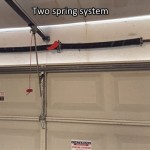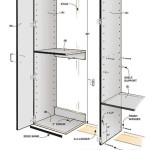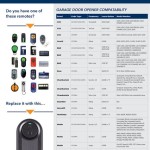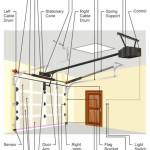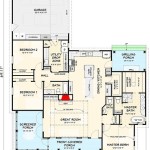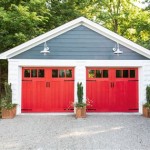Garage Door Not Closing Evenly: Troubleshooting and Solutions
A garage door that fails to close evenly, leaving a visible gap on one side or the other, presents a multifaceted problem that transcends mere inconvenience. It compromises the security of the garage and, by extension, the home. It exposes the interior to the elements, potentially leading to increased energy costs and water damage. The issue, if left unaddressed, can also accelerate wear and tear on the garage door components, leading to more costly repairs down the line. Addressing an unevenly closing garage door requires a systematic approach, involving careful observation, diagnosis, and a willingness to undertake necessary repairs or seek professional assistance.
The underlying causes of this problem can range from minor mechanical misalignments to more substantial structural issues. A thorough understanding of the potential culprits is essential for effective troubleshooting. This article outlines the common reasons why a garage door might not close evenly and provides a detailed guide to diagnosing and resolving these issues.
Track Obstructions and Misalignment
The garage door tracks serve as the guiding rails for the door as it moves up and down. They are crucial for ensuring smooth and even operation. Any obstruction within these tracks, or any misalignment of the tracks themselves, can directly contribute to an uneven closing pattern. Small debris, such as pebbles, leaves, or even accumulated dirt, can lodge within the track, impeding the rollers and causing the door to bind on one side. A more significant obstruction, such as a bent section of the track or a displaced mounting bracket, will have a more pronounced effect.
Regular inspection of the tracks is paramount. Begin by visually examining the entire length of both tracks, looking for any visible obstructions or signs of damage. Pay close attention to the areas where the rollers make contact with the track. Use a flashlight to illuminate the interior of the track and identify any hidden debris. If obstructions are present, carefully remove them using a brush, vacuum cleaner, or a damp cloth. Avoid using excessive force, as this could potentially damage the track or rollers.
Misalignment of the tracks can occur due to loose mounting hardware, accidental impacts, or even gradual settling of the building structure. To check for misalignment, use a level to ensure that both tracks are perfectly vertical. If one track is tilted or angled differently than the other, it will cause the door to bind. The horizontal sections of the tracks should also be level and aligned with each other. If misalignment is detected, loosen the mounting brackets that secure the track to the wall and carefully adjust the track until it is properly aligned. Once the alignment is corrected, securely tighten the mounting brackets. If the mounting brackets are damaged or corroded, they should be replaced.
Furthermore, examine the rollers themselves. Worn or damaged rollers can contribute to uneven movement. If the rollers are visibly cracked, chipped, or flattened, they should be replaced. The rollers should spin freely within the track. If a roller is seized or difficult to rotate, it may be due to dirt, rust, or a lack of lubrication. In such cases, cleaning the roller and applying a silicone-based lubricant may resolve the issue. If the roller remains stiff or damaged after cleaning and lubrication, it should be replaced.
Problems with the Garage Door Springs
The garage door springs are critical components of the garage door system. They provide the counterbalancing force that allows the door to be raised and lowered with relative ease. Most garage doors utilize either torsion springs, mounted horizontally above the door opening, or extension springs, located along the sides of the tracks. When these springs are improperly adjusted, damaged, or broken, the door can become unbalanced, leading to uneven closing and potential safety hazards.
A broken spring is typically easy to identify. The door will feel significantly heavier than usual, and it may be difficult or impossible to lift manually. In the case of torsion springs, a visible gap between the coils is a clear indication of a break. With extension springs, the broken spring may be detached from its mounting bracket or appear stretched and distorted.
Under no circumstances should an attempt be made to repair or replace a garage door spring without proper training and tools. Garage door springs are under tremendous tension, and improper handling can result in serious injury or even death.
Contacting a qualified garage door technician is strongly recommended in such situations.Even if the springs are not broken, improper adjustment can still cause the door to close unevenly. The springs must be properly tensioned to provide the correct amount of counterbalance. If one spring is weaker than the other, or if the tension is not evenly distributed, the door will be off-balance. Adjusting the tension of garage door springs is a complex and potentially dangerous task. It is best left to professionals who have the necessary expertise and equipment to perform the adjustment safely and effectively.
In addition to tension, the condition of the springs should be assessed. Springs can weaken over time due to metal fatigue, corrosion, or repeated use. If the springs are showing signs of wear, such as rust or excessive stretching, they may need to be replaced. Replacing both springs simultaneously is generally recommended, even if only one spring appears to be damaged. This ensures that the door remains balanced and prevents premature failure of the remaining spring.
Cable Issues and Drum Alignment
Garage door cables work in conjunction with the springs to lift and lower the door. These cables are typically made of strong, braided steel and are attached to the bottom corners of the door, running up and over the cable drums located at the ends of the torsion spring shaft. Proper cable tension and drum alignment are essential for ensuring smooth and even door operation. If a cable is frayed, broken, or improperly wound on the drum, it can cause the door to close unevenly.
Carefully inspect the cables for any signs of damage. Fraying, kinking, or corrosion can weaken the cable and make it more susceptible to breakage. If any damage is detected, the cable should be replaced immediately.
Replacing garage door cables can be dangerous due to the high tension involved. It is strongly recommended to hire a qualified garage door technician to perform this task.
The cables must be properly seated within the grooves of the cable drums. If a cable has slipped off the drum or is not winding evenly, it can cause the door to bind. This can sometimes be caused by the drum being out of alignment with the torsion spring shaft. Ensure that the drums are securely fastened to the shaft and that they are properly aligned. If a drum is loose or misaligned, it may need to be adjusted or replaced.
Cable tension is also a critical factor. The cables must be equally tensioned to ensure that the door is lifted and lowered evenly. If one cable is looser than the other, it can cause the door to sag on one side. Adjusting cable tension is a delicate process that requires specialized tools and knowledge. It is best left to a qualified technician.
Furthermore, inspect the sheaves, which are the pulleys that guide the cables. Damaged or worn sheaves can impede cable movement and contribute to uneven door operation. If the sheaves are cracked, chipped, or difficult to rotate, they should be replaced.
Besides mechanical issues, problems in the garage door opener can also contribute to the door not closing evenly.
Garage Door Opener Malfunctions
While the garage door opener primarily automates the raising and lowering of the door, its proper functioning is intrinsically linked to the door's even closure. Malfunctions within the opener's mechanism, limit settings, or safety sensors can all contribute to the problem of an unevenly closing door.
The limit settings on the garage door opener dictate the upper and lower travel limits of the door. These settings tell the opener when to stop the door from moving up or down. If the lower limit setting is improperly adjusted, the door may not close completely or may stop short on one side. To adjust the limit settings, consult the owner's manual for the specific garage door opener model. The adjustment process typically involves using a screwdriver to turn adjustment screws located on the opener unit. Make small adjustments and test the door's operation after each adjustment until the desired closing position is achieved. Ensure that the door seals tightly against the floor along its entire length.
The safety sensors, also known as photo eyes, are another crucial component of the garage door opener system. These sensors are typically located near the bottom of the door opening and are designed to prevent the door from closing if an obstruction is detected in its path. If the sensors are misaligned, dirty, or damaged, they may send a false signal to the opener, causing the door to stop or reverse direction before it is fully closed. Inspect the sensors to ensure that they are properly aligned and free from obstructions. Clean the lenses of the sensors with a soft, damp cloth. If the sensors are damaged or malfunctioning, they should be replaced.
The garage door opener's motor and drive mechanism can also contribute to uneven door closure. If the motor is weak or the drive mechanism is worn, it may not provide sufficient power to close the door evenly. In such cases, the opener may need to be repaired or replaced. Listen for unusual noises emanating from the opener during operation. Grinding, clicking, or rattling sounds can indicate internal problems that require professional attention.
Check the trolley, which is the part of the opener that connects to the door. The trolley moves along the rail to open and close the door. Make sure it is properly attached and that there are no obstructions along the rail preventing its smooth movement.
In summary, various factors including obstructions, misalignment, spring issues, cable problems and opener malfunctions can cause uneven closing. A systematic approach to diagnosing and addressing these issues is crucial for restoring proper door function and ensuring safety and security.

Why Your Garage Door Won T Close On One Side Whitby Doors

Why Your Garage Door Won T Close On One Side Whitby Doors

Garage Door Not Closing Evenly Allgood Company

How To Balance An Uneven Garage Door Yourself

Garage Door Not Level When Closed Bonus Tip Inside

Why Is My Garage Door Not Level When Closed Precision Services

Uneven Garage Door Here S How To Fix It Fast Safely

How To Fix Uneven Or Sagging Garage Doors Pro Entry

Why Is My Garage Door Not Level When Closed Precision Services

Garage Door Won T Fully Close On One Side Here S How To Fix It Northside

